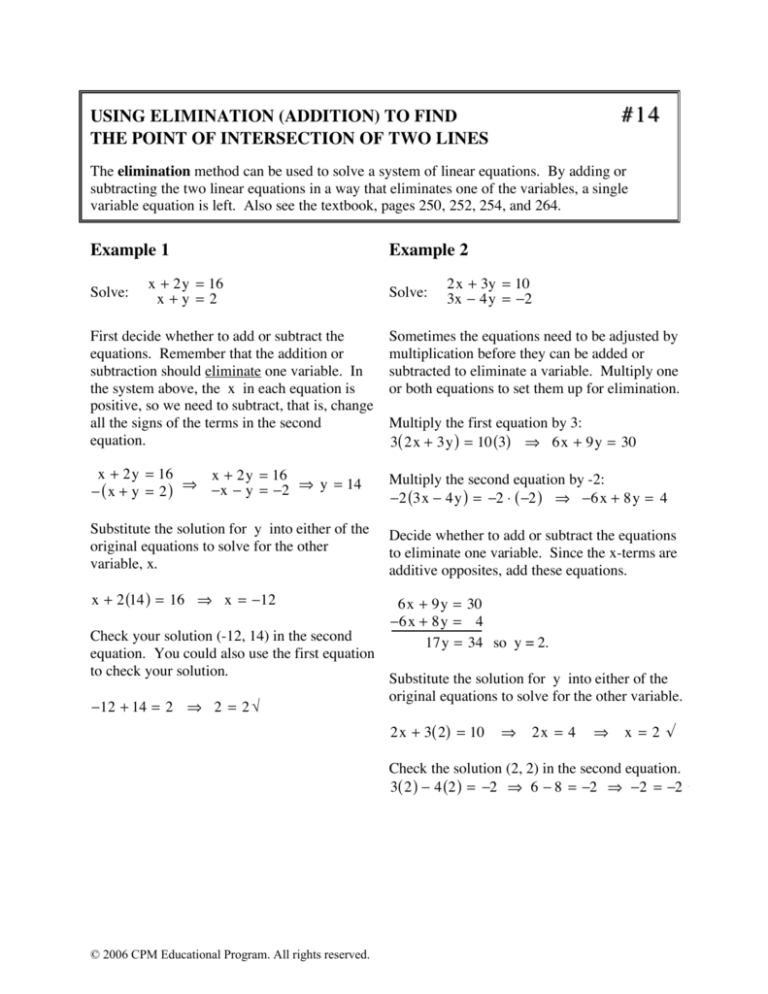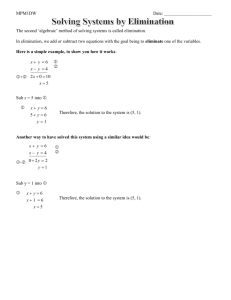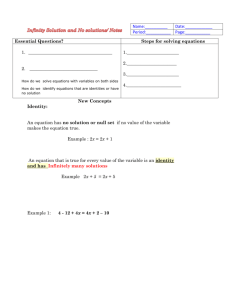
#14
USING ELIMINATION (ADDITION) TO FIND
THE POINT OF INTERSECTION OF TWO LINES
The elimination method can be used to solve a system of linear equations. By adding or
subtracting the two linear equations in a way that eliminates one of the variables, a single
variable equation is left. Also see the textbook, pages 250, 252, 254, and 264.
Example 1
Solve:
x + 2y = 16
x+y =2
First decide whether to add or subtract the
equations. Remember that the addition or
subtraction should eliminate one variable. In
the system above, the x in each equation is
positive, so we need to subtract, that is, change
all the signs of the terms in the second
equation.
Example 2
Solve:
2x + 3y = 10
3x ! 4y = !2
Sometimes the equations need to be adjusted by
multiplication before they can be added or
subtracted to eliminate a variable. Multiply one
or both equations to set them up for elimination.
Multiply the first equation by 3:
3( 2x + 3y ) = 10 (3) ⇒ 6x + 9y = 30
x + 2y = 16
x + 2y = 16
⇒ !x ! y = !2 ⇒ y = 14
! (x + y = 2)
Multiply the second equation by -2:
!2 (3x ! 4y ) = !2 " ( !2 ) ⇒ !6 x + 8y = 4
Substitute the solution for y into either of the
original equations to solve for the other
variable, x.
Decide whether to add or subtract the equations
to eliminate one variable. Since the x-terms are
additive opposites, add these equations.
x + 2 (14 ) = 16 ⇒ x = !12
6x + 9y = 30
!6x + 8y = 4
17y = 34 so y = 2.
Check your solution (-12, 14) in the second
equation. You could also use the first equation
to check your solution.
!12 + 14 = 2 ⇒ 2 = 2 !
Substitute the solution for y into either of the
original equations to solve for the other variable.
2x + 3( 2) = 10
⇒
2x = 4
⇒
x =2 √
Check the solution (2, 2) in the second equation.
3( 2 ) ! 4 (2 ) = !2 ⇒ 6 ! 8 = !2 ⇒ !2 = !2 √
© 2006 CPM Educational Program. All rights reserved.
Solve each system of linear equations using the Elimination Method.
1. x + y = -4
-x + 2y = 13
2. 3x – y = 1
-2x + y = 2
3. 2x + 5y = 1
2x – y = 19
4. x + 3y = 1
2x + 3y = -4
5. x – 5y = 1
x – 4y = 2
6. 3x – 2y = -2
5x – 2y = 10
7. x + y = 10
15x + 28y = 176
8. x + 2y = 21
9x + 24y = 243
9. 4x + 3y = 7
2x – 9y = 35
10. 2x + 3y = 0
6x – 5y = -28
11. 7x – 3y = 37
2x – y = 12
12. 5x – 4y = 10
3x – 2y = 6
13. x – 7y = 4
3x + y = -10
14. y = -4x + 3
3x + 5y = -19
15. 2x – 3y = 50
7x + 8y = -10
16. 5x + 6y = 16
3x = 4y + 2
17. 3x + 2y = 14
3y = -2x + 1
18. 2x + 3y = 10
5x – 4y = 2
19. 5x + 2y = 9
2x + 3y = -3
20. 10x + 3y = 15
3x – 2y = -10
Answers
1. (-7, 3)
2. (3, 8)
3. (8, -3)
4. (-5, 2)
5. (6, 1)
6. (6, 10)
7. (8, 2)
8. (3, 9)
9. (4, -3)
10. (-3, 2)
11. (1, -10)
12. (2, 0)
13. (-3, -1)
14. (2, -5)
15. (10, -10)
16. (2, 1)
17. (8, -5)
18. (2, 2)
19. (3, -3)
20. (0, 5)
© 2006 CPM Educational Program. All rights reserved.










